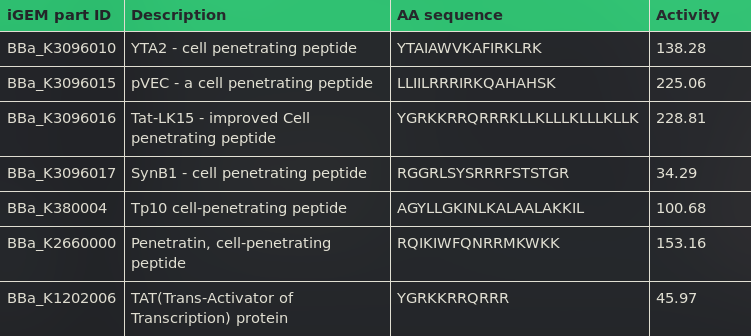Part:BBa_K3096015
pVEC - a cell penetrating peptide
pVEC (peptide vascular endothelial-cadherin) is a cell-penetrating peptide, which transports proteins through coadministration.
Contents
Biology & Usage
Through their penetrating activity, Cell penetrating peptides can be utilized as carriers of peptide- and protein-based pharmaceuticals, such as Insulin, across membranes across rat intestinal cells (Kamei et al.). This is highly relevant since advances in biotechnology resulted in therapeutics, which can only be administered parenterally due to their minimal bioavailability (Kamei et al.). Since cytotoxic effects have occurred, induced by the disintegration of the plasma membrane, improvement and development of cell-penetrating peptides is necessary.
Kamei et al. propose that cell-penetrating peptides gain their activity through the abundance of multiple positive charges (arginine, R) and the ability to form an amphipathic helix.
pVEC is derived from a segment of the transmembrane domain part of a murine vascular endothelial-cadherin protein, which is involved in cell-cell adhesion (Elmquist et al.). Its ability to enter the cell can mostly be explained by the N-terminal stretch of hydrophobic amino acids, which interact with the plasma membrane and potentially induces endocytosis (Elmquist et al.). It was shown by Kamei et al. that the coadministration of pVEC with Insulin increases its intestinal uptake in rat cells, suggesting it to be a suitable tool for the oral delivery route of drugs.
Meanwhile, Elmquist et al. also showed that incubation with 10µM pVEC for up to 1 hour at 37°C did not cause significant leakage (measured by lactate dehydrogenase in the extracellular space), indicating that pVEC does not confer to a strong cytotoxic effect. This is beneficial if the cell-penetrating peptide is destined to be used in drug delivery.
Characterisation by iGEM Tuebingen 2019

The results of the characterization are shown in the Table, where common or new CPPs are shown with their respective penetrability. Of the CPPs tested, pVEC is demonstrated to have the second-highest penetrability, following the penetration improved Tat-LK15.
To use the tool and to get more information on how it operates, please visit the wiki of iGEM Team Tübingen 2019.
Biosafety
Together with professional safety officials, Team iGEM Tuebingen 2019 has evaluated the biosafety of cell-penetrating peptides and has come to the conclusion that cell-penetrating peptides are to be classified as BSL1.
Sequence and Features
pVEC consists of a stretch of 18 amino acids, with the N-terminal hydrophobic amino acids being crucial determinants of the uptake. We propose future iGEM Teams to improve this part by exchanging Arg6, Arg8 or Ser17 by alanine. According to Elmquist et al., this is should increase the penetrating activity.
- 10COMPATIBLE WITH RFC[10]
- 12COMPATIBLE WITH RFC[12]
- 21COMPATIBLE WITH RFC[21]
- 23COMPATIBLE WITH RFC[23]
- 25COMPATIBLE WITH RFC[25]
- 1000COMPATIBLE WITH RFC[1000]
References
- Kamei, Noriyasu, et al. "Usefulness of cell-penetrating peptides to improve intestinal insulin absorption." Journal of Controlled Release 132.1 (2008): 21-25.
- Elmquist, Anna, Mats Hansen, and Ülo Langel. "Structure–activity relationship study of the cell-penetrating peptide pVEC." Biochimica et Biophysica Acta (BBA)-Biomembranes 1758.6 (2006): 721-729.
| None |
